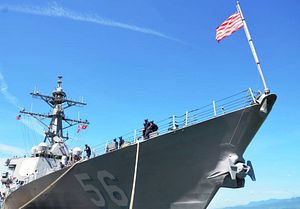For decades, the United States has maintained major logistics and repair hubs for its fleet at bases in Japan and Guam. As the U.S. has renewed its focus on the Pacific through the “rebalance,” it has also steadily expanded partnerships and expeditionary logistical capabilities to sustain its ships locally in the South China Sea. Receiving maintenance in Vietnam, Singapore, the Philippines, and other countries in Southeast Asia allows U.S. ships to remain ‘on station’ longer without having to return to the large facilities in Japan. At the same time, the Navy is creating new afloat, expeditionary capabilities (or re-kindling old ones) to provide repairs and replenishment without the need for traditional fixed facilities at all. In addition to enabling more persistent naval presence during peacetime, these partnerships and capabilities could provide a potent wartime repair and replenishment ability to help return ships to the fight faster.
New Maintenance Partnerships in the South China Sea
In early October the U.S. destroyer USS John S. McCain and a submarine tender visited Vietnam’s newly-refurbished port in Cam Ranh bay on the South China Sea. Unarmed U.S. naval auxiliary ships, like salvage tugs and replenishment oilers, have been visiting Cam Ranh bay for voyage repairs since 2010 after negotiations and plans starting in 2008, but the McCain is the first U.S. warship to visit the port since the Vietnam War. Two of the ship’s namesakes have deep significance with Vietnam; Admiral John S. McCain Jr. headed the U.S. Pacific Command during the war, and his son, Senator John S. McCain III, a naval aviator, was a prisoner of war.
If warships begin to receive repairs in Cam Ranh bay as well, it would significantly increase the Navy’s capacity to sustain its presence in the South China Sea. This week, Vietnam’s Vice Defense Minister affirmed that Vietnam, “will support the U.S and other partners to intervene in the region as long as it brings peace, stability and prosperity.” This public signal of conditional support for U.S. “intervention” is unusual for a country that traditionally eschews alliances and foreign bases. However, it is unclear whether future Vietnamese support or maintenance agreements would include repairing battle damage U.S. warships might receive in a potential future conflict, or would just sustain its peacetime presence.
In September, the USS Shiloh, a cruiser based in Yokosuka, Japan, conducted a scheduled maintenance period in Singapore. The U.S. Navy has a long presence in Singapore, where the staff of Commander, Logistics Group Western Pacific has been based since forced to leave the Philippines in 1991. Singapore is also hosting rotationally deployed U.S. Littoral Combat Ships, to provide constant presence in Southeast Asia. But as a planned, life-cycle shipyard period, the Shiloh’s maintenance was unique; U.S. ships are generally legally restricted in the types of repairs that they can receive from foreign facilities, which is typically only emergent work necessary for safety or essential mission accomplishment. Aligning the resources and authorities to provide regular maintenance and installations outside the repair facilities in Japan and Guam is potentially more important for sustaining U.S. ships in the region than emergent repair agreements in places like Vietnam.
‘Expeditionary Maintenance’ and At-Sea Logistics
The U.S. Navy is not just improving relationships with foreign shipyards in the region, but expanding its ability to provide repairs and resupply with afloat facilities. Rear Admiral Gabrielson, commander of the U.S. Navy logistics group based in Singapore, recently described the new capabilities he is exploring to provide under the Expeditionary Maintenance Capabilities concept to USNI News.
The goal of the concept is to provide maintenance to ships at sea (or anchored in protected waters), and in ports that do not have significant repair facilities of their own. One option looks to build modular repair facilities and install them on fast logistics ships, effectively turning them into small, temporary ship tenders (ships designed to provide repairs to other ships). The second looks at using other existing repair facilities, like submarine tenders, in new expeditionary and non-traditional roles.
Admiral Gabrielson revealed that one of those potential new roles was demonstrated earlier in October when a submarine tender reloaded a destroyer’s vertical missile launchers at sea. This is a major proof-of-concept that could substantially extend a warship’s ability to fight in a future clash. The United States regularly replenishes supplies like fuel, food, and parts, and some ammunition (like bullets or artillery shells) at sea. But the missiles that make up cruisers’ and destroyers’ main weapons systems have generally had to be loaded at special port facilities. This means that a warship’s usefulness in a conflict zone is virtually gone once it has expended its missiles. The lost time required to transit to an equipped port and back to the conflict could significantly impact combat operations. If cruisers and destroyers can now reload their missiles at sea, they can return to the conflict faster.
In concert with other new logistics capabilities tested this year, like tanker-oiler fuel consolidations that substantially stretch the U.S. fleet’s ability to refuel itself at sea, these partnerships, concepts, and capabilities could provide the U.S. Navy with a more robust, sustained presence in Southeast Asia. Providing emergent repair, scheduled maintenance, and rearmament in the region relieves ships of having to travel the significant distances to the major U.S. Navy bases in Japan and Guam. These capabilities will allow the United States to keep its ships on station to provide persistent regional presence in peacetime, and expanded capabilities to sustain combat operations in potential future clashes.

































